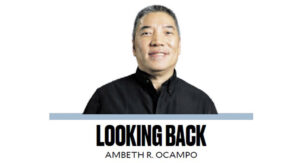History in cursive

I often assign my students to transcribe 19th-century notarial documents in Tagalog because many of them, who read and write on their smartphones, are not used to reading handwriting in cursive script.
Going over American soldiers’ letters home from the islands during the Philippine-American War preserved in the William L. Clements Library, University of Michigan, gave me more primary source material to share in class. I must admit I also struggle with the handwriting and grammar of the young men who volunteered to fight in the Philippines. I struggle with the content of some of the letters, like what really happened when the smoke cleared following the Battle for Caloocan in February 1899.
Arthur W. Fergusson, first lieutenant, 26th Infantry USV narrated: “On the tenth day of February 1899. I was engaged in the taking of Caloocan by the U.S. Troops, being a corporal in Co[mpany] W 20th Kansas Inf[antry]. Immediately after crossing the insurgent trenches, about 300 yards south of the Caloocan church, I heard a shot fired to my left and rear, and looking that way, saw a native falling apparently lifeless to the ground. Major Metcalf was standing about six or eight feet in front of the native with a smoking pistol and the impression received was that the Major had shot the native, but other matters called me and I went on with the line.”
On July 24, 1899, Private Harris O. Huskey, Com(pany) K, 20th Kansas Inf[antry US V(olunteers) wrote: “That at the battle of Caloocan he was orderly for Major W.S. Metcalf 20th Kansas Inf[antry US Volunteers]. That at a point where the Insurgent trenches cross the traveled road near and to the right of the tramway, he saw a prisoner brought out of the trenches and to Major Metcalf … [who] shot the prisoner with his revolver, and at the time of shooting the prisoner was unarmed and on his knees.”
On July 25, 1899, Private Donald Thorne narrated, “That on Feb[ruary] 10 [1899] during the fighting at Caloocan at the time the firing line had reached a point about half a mile beyond the town of Caloocan, and about the time the firing had newly ceased, I crossed from the right of the right as Co. H which was toward the left, to see if my brother, Oscar Thorne, who belonged to Co. H had come out all right. While passing in the rear of ‘H’ Company, I saw two Filipinos lying on the ground and near each other. One of them was wounded, and the other supposed from appearances was dead. I had passed them a few steps when I heard a shot fired and looking around saw Captain Bishop, Co[mpany] M 20th Kansas Infantry USV over them and emptying his revolver apparently [on] the bodies of the two Filipinos I had just passed. Captain Bishop fired three shots after I turned around. This occurred about fifty yards in rear of the firing line.”
On July 25, 1899, Private Donald Thorne, Jr. gave almost the same testimony as his brother above, word for word; he was looking for his brother when he saw Capt. Bishop shoot the Filipino prisoners in cold blood. The investigation went on for three years and was kept up by the likes of Edmund Bottwood who wrote two letters to a US Senate subcommittee investigating atrocities during the Philippine-American War. He reminded them of his testimony and five names he supplied to Major Mallory at San Fernando, Pampanga, who had seen prisoners killed by officers of the 20th Kansas company. Evidence in Metcalf’s favor, he said, showed: “that the investigation at Manila did not develop the full facts in the case. It was the general opinion in our regiment at the time that not one but several prisoners were killed at the point named during the Battle of Caloocan February 10, 1899, and that an examination of the men whose names I gave Maj. Mallory will establish the fact … rigid reexamination of Huskey before your Committee would reveal some startling evidence.”
A week later, on Jan. 24, 1902, Bottwood wrote the Senate stating that: “there were more than two [Filipino prisoners killed], and I believe more than six prisoners killed within the shadow of Col. Metcalf presence at Caloocan … and it pains me to state it, for the man himself was killed a few days afterward, bayonet a Filipino through the head and that in trying to disengage his bayonet the body was jerked and down quite a distance on the ground … [he saw a trench] filled promiscuously [with] the dead bodies of a large number of Filipinos. The ground was very dry and hard and the bodies had been imperfectly covered, several legs and arms protruding …
“Col. Metcalf is not the only one guilty but there seems to be no way to get at the others now … I believe you are just beginning to get at the facts and if the crimes committed that day and the crookedness since resorted to to cover up those crimes are fully unearthed, the stench will rise to Heaven and call down justice on the guilty parties.”
What terrible things young people, both Filipino and American, saw in the battlefields. History read first hand may be tedious but it is more engaging than textbook history. It is surely more effective in teaching appreciation for the past and being Filipino than memorizing the “Bagong Pilipinas” hymn and oath for Monday flag ceremony.
—————-
Comments are welcome at [email protected]